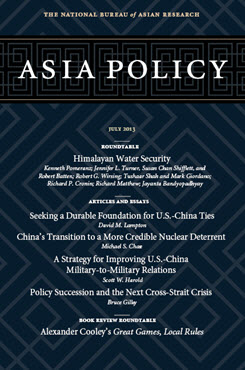China's Upstream Advantage in the Great Himalayan Watershed
This is one of seven essays in the roundtable “Himalayan Water Security: The Challenges for South and Southeast Asia.”
The four-character Chinese idiom “benefiting from the gifts of nature” (de tian du hou) captures China’s riparian advantage in the great Himalayan watershed. In Mother Nature’s luck of the draw, China is the big winner; many of the largest rivers in the Himalayan watershed originate in the glaciers of Tibet. The Yellow, Yangtze, Mekong, Brahmaputra, Salween, Sutlej, and Indus rivers provide water to 1.5 billion people from the mountains in Tibet down to deltas in Bangladesh, China, India, Myanmar, Pakistan, and Vietnam. As the upstream power, China has the ability to control the quality and flow of water that reaches its downstream neighbors.
The confluence of three factors—China’s increasing demand for hydroelectric power, water scarcity, and the transboundary nature of rivers—are raising tensions in the great Himalayan watershed. China’s hunger for energy to build cities and fuel industries, while at the same time reducing greenhouse gas emissions, has sparked a new wave of planning for dozens of mega-dams along the mainstreams of these transboundary rivers. Yet Beijing’s lack of transparency about its dam-building projects and disinterest in formally cooperating or engaging with the lower riparian states in multilateral forums frustrate its downstream neighbors, which notably are also damming the same rivers for electricity generation.
The region desperately needs institutionalized water-sharing agreements and practices because countries are increasingly overdeveloping and wasting scarce freshwater resources. This overuse is occurring against the backdrop of climate change’s unknown effects on the Himalayan river basins. The key challenge to the region’s water-sharing efforts is the acute power imbalance between China and its neighbors—China not only controls the headwaters of these rivers but is also the most powerful state in the region, economically and militarily. Thus, Beijing has little incentive to enter into formal cooperative water agreements with its weaker downstream neighbors.
This essay first discusses how China’s rising demand for both energy and freshwater are driving the dam-building projects that endanger the flow and water quality of rivers feeding the downstream countries of South and Southeast Asia. It then considers how China’s aversion to formal water-sharing agreements is frustrating its neighbors. Although no entity can force China to cooperate, more could be done to fill the information gap on the broader costs of dam building. The essay concludes by proposing a “carrot and stick” approach that would encourage Chinese policymakers to sustainably develop the upstream waters—not simply to benefit downstream countries but to protect China’s own water security.
The Ripple Effect of China’s Water Needs
The domestic implications of China’s energy demand. China’s voracious appetite for energy continues to grow. The International Energy Agency forecasts that the country’s energy demand will rise by 60% from 2012 to 2035. [1] As smog increasingly blankets Chinese cities, Chinese citizens are demanding more aggressive action from the government to clean the air. Beijing has set targets to secure 15% of the country’s energy from non-fossil fuel sources by 2020, with 9% projected to come from hydroelectric power. In particular, Chinese leaders recognize the need to move away from coal, which currently supplies 70% of the country’s electricity. To reach this goal, China will need to double its output of hydroelectric power. [2]
This demand for hydroelectric power as an alternative to coal is problematic because China is a water-stressed nation. Although water is abundant in absolute terms, the country’s per capita freshwater resources are only 2,093 cubic meters, one-quarter of the global average. [3] According to a survey released by the Chinese Ministry of Water Resources in March 2013, an alarming 23,000 rivers in the country have disappeared entirely in just the past 60 years. [4] Rapid urbanization and industrialization have…
[1] See “World Energy Outlook 2012,” International Energy Agency, 2012, http://www.iea.org/publications/freepublications/publication/English.pdf.
[2] Renee Cho, “The Push to Dam China’s Rivers,” State of the Planet, web log, Earth Institute, May 19, 2011, http://blogs.ei.columbia.edu/2011/05/19/the-push-to-dam-china%e2%80%99s-rivers/.
[3] “Renewable Internal Freshwater Resources Per Capita (Cubic Meters),” World Development Indicators, World Bank, http://data.worldbank.org/indicator/ER.H2O.INTR.PC.
[4] Andrew Jacobs, “Plans to Harness Chinese River’s Power Threaten a Region,” New York Times, May 4, 2013, http://www.nytimes.com/2013/05/05/world/asia/plans-to-harness-chinas-nu-river-threaten-a-region.html.
About Asia Policy
Asia Policy is a peer-reviewed scholarly journal presenting policy-relevant academic research on the Asia-Pacific that draws clear and concise conclusions useful to today’s policymakers. Asia Policy is published quarterly in January, April, July, and October and accepts submissions on a rolling basis. Learn more


